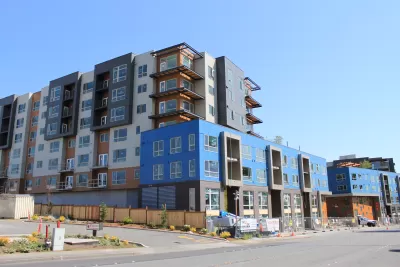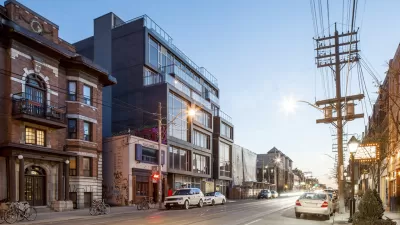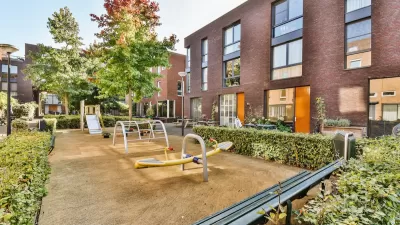Last week's urbanism social media landscape was dominated by discussion of an article that digs into the historical and technical origins of the contemporary mid-rise apartment building type.

Justin Fox writes on a controversial topic familiar to planners—the general uniformity of new buildings around the United States.
These buildings are in almost every U.S. city. They range from three to seven stories tall and can stretch for blocks. They’re usually full of rental apartments, but they can also house college dorms, condominiums, hotels, or assisted-living facilities. Close to city centers, they tend toward a blocky, often colorful modernism; out in the suburbs, their architecture is more likely to feature peaked roofs and historical motifs. Their outer walls are covered with fiber cement, metal, stucco, or bricks.
Fox also fins evidence that mid-rise buildings are being built in greater numbers than ever—or at least since the Census Bureau started keeping track in 1972.
The conversation about the aesthetic characteristics of contemporary architectural styles (the kind built at large scale in cities all over the country, and not the signature pieces by international starchitects) is a familiar one. Patrick Sisson wrote on the subject most recently in December 2018, identifying a name for the style, "Fast-casual architecture," and connecting contemporary style to the contemporary housing crisis.
Fox digs into the stick construction techniques that these buildings have in common—wood framing that can save massive amounts of money for developers compared to concrete, steel, or masonry. Fox also traces the origins of the wood-framed building as the status quo of American apartment construction to the Uniform Building Code, first issued in 1927. Far from a damning critique, Fox points out the positives of wood construction before also mentioning the fire danger presented by these buildings before fire and life systems are added.
FULL STORY: Why America’s New Apartment Buildings All Look the Same

Florida Considers Legalizing ADUs
Current state law allows — but doesn’t require — cities to permit accessory dwelling units in single-family residential neighborhoods.

Manufactured Crisis: Losing the Nation’s Largest Source of Unsubsidized Affordable Housing
Manufactured housing communities have long been an affordable housing option for millions of people living in the U.S., but that affordability is disappearing rapidly. How did we get here?

Americans May Be Stuck — But Why?
Americans are moving a lot less than they once did, and that is a problem. While Yoni Applebaum, in his highly-publicized article Stuck, gets the reasons badly wrong, it's still important to ask: why are we moving so much less than before?

EV Chargers Now Outnumber Gas Pumps by Nearly 50% in California
Fast chargers still lag behind amidst rapid growth.

Affordable Housing Renovations Halt Mid-Air Amidst DOGE Clawbacks
HUD may rescind over a billion dollars earmarked for green building upgrades.

Has Anyone at USDOT Read Donald Shoup?
USDOT employees, who are required to go back to the office, will receive free parking at the agency’s D.C. offices — flying in the face of a growing research body that calls for pricing parking at its real value.
Urban Design for Planners 1: Software Tools
This six-course series explores essential urban design concepts using open source software and equips planners with the tools they need to participate fully in the urban design process.
Planning for Universal Design
Learn the tools for implementing Universal Design in planning regulations.
City of Moreno Valley
Institute for Housing and Urban Development Studies (IHS)
City of Grandview
Harvard GSD Executive Education
NYU Wagner Graduate School of Public Service
City of Cambridge, Maryland
Newport County Development Council: Connect Greater Newport





























